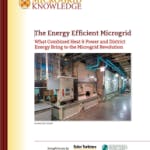The time is right for microgrids. And it’s not just to protect our power supply from severe storms, as our new Think Microgrid report explains. Here’s an excerpt.
It wasn’t just the severity of Superstorm Sandy (See related article) that led to today’s new emphasis on grid resiliency and microgrids; it was also the timing. A convergence of other events – economic, technological and market – made North America ripe for microgrids and distributed energy.
First, the prices of natural gas – the fuel most often used in combined heat and power (CHP) microgrids – fell dramatically in 2008. More efficient drilling and growing abundance of supply contributed to the price drop. This created low-cost and ample fuel for CHP microgrids.
The forecast for natural gas continues to be bullish, with the US Information Administration predicting a 56 percentincrease in total natural gas production from 2012 to 2040. The American Gas Association says a 100 to 150-year gas supply exists in North America. Such fuel availability bodes well for future development of CHP and district energy (DE) microgrids.
Second, software and technology developers have bought new, affordable programs, communication networks and controls to microgrids. As a result, today’s microgrids can interact in a smarter more flexible way with the outside grid. They also can manage with greater sophistication their own resources – load, generation dispatch, fuels, and storage. Scalable and efficient gas turbines are now economically competitive and deployable in multiple settings in size ranges ideal for city districts, campuses and connected communities.
Third, several market changes are under way that encourage microgrid adoption.
Wholesale energy markets increasingly allow participation of distributed energy resources. This gives grid-connected microgrids an opportunity to earn revenue in return for services they provide that strengthen the larger grid. These include demand response, or balancing, frequency and regulation services.
Other factors that may lead to more microgrids include:
- A market is developing for distributed energy resources as ‘non-transmission alternatives’ (NTAs). In this case, a microgrid might avert grid congestion and reduce locational marginal prices. Or an NTA may fill a new supply need, and do so in a less expensive, less intrusive way than a large transmission line.
- Microgrids, CHP and district energy can help North America reach various emissions reductions goals and requirements. These environmental efforts – along with the low cost of natural gas – are encouraging retirement of coal-fired plants at a surprising rate. North America needs to replace the retiring plants. CHP and district energy offer a cleaner, more efficient alternative.
“There is a lot of new investment that will be required in our electric distribution infrastructure. Most transformers are 30 years old. There needs to be transmission upgrades for renewables. Having distribution generation circumvents those needs. Yet, we’re still in that old mentality of let’s build large central plants and run wires.” Chris Lyons, Manager of Power Generation, Solar Turbines
Read the full report, The Energy Efficient Microgrid: What Combined Heat & Power and District Energy Bring to the Microgrid Revolution, provided as a free download, courtesy of Solar Turbines and the International District Energy Association.






